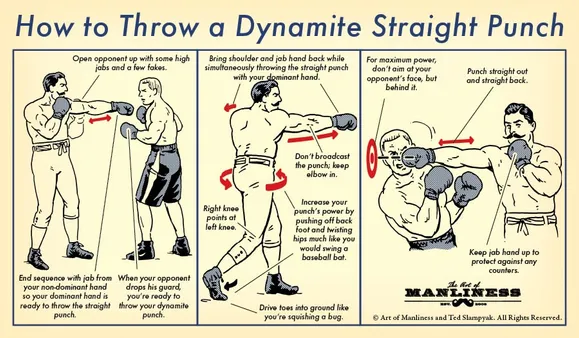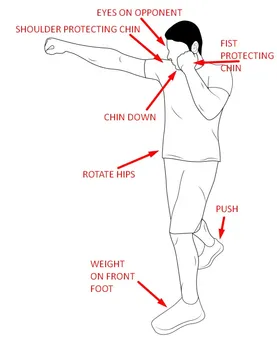Table of Contents
Welcome to Kizworld, your ultimate resource for mastering the art of punching. In this comprehensive guide, we'll delve into the techniques and strategies that will transform you into a punching powerhouse. From perfecting your stance and footwork to generating explosive power and pinpoint accuracy, we'll guide you every step of the way. Whether you're a beginner looking to learn the basics or an experienced fighter seeking to refine your skills, our insights will help you unleash the full potential of your punches. So, get ready to discover How to do a punch with precision, power, and control. Let's dive in!
How to do a Punch: Unleash Your Inner Power with Precision and Technique
I. How to Throw a Punch: Techniques and Tips for Effective Strikes
How to Throw a Punch: Techniques and Tips for Effective Strikes
Proper Mechanics: The Foundation of a Powerful Punch
A critical aspect of throwing a punch is mastering the proper mechanics. This involves maintaining the correct posture, footwork, and technique to deliver maximum power and accuracy. Stand with your feet shoulder-width apart, knees slightly bent, and your weight distributed evenly. Your non-punching hand should be raised to protect your face, while your punching hand is cocked back, with your elbow close to your body.
To throw a punch, start by rotating your hips and shoulders simultaneously, generating power from your core. As your arm extends, keep your fist tight and your wrist straight. Contact your target with the first two knuckles of your fist, and immediately retract your hand to protect yourself. Remember to breathe consistently throughout the punching motion to maintain power and control.
Types of Punches: Exploring the Variations
Boxing encompasses a wide range of punches, each with its unique characteristics and applications. The jab is a quick, straight punch that extends your lead hand. It's commonly used to set up combinations, measure your opponent's distance, and keep them at bay. The cross is a powerful, straight punch thrown with your rear hand. It's often used as a knockout blow due to its ability to land with great force and accuracy.
The hook is a short, looping punch thrown with the lead hand. It's particularly effective at close range and can be used to attack the opponent's head or body. The uppercut is a rising punch thrown with the rear hand, targeting the opponent's chin or solar plexus. It's a powerful punch that can be used to counter an opponent's attack or to finish a combination.
Straight PunchesHook PunchesJabLeft HookCrossRight Hook
In addition to these basic punches, boxing also includes various combinations and variations, including the one-two (a jab followed by a cross), the double jab (two quick jabs in succession), and the uppercut-hook combination (an uppercut followed by a hook).
Practice and Repetition: The Path to Mastery
As with any skill, practice is paramount to mastering the art of punching. Start by shadowboxing in front of a mirror to perfect your form and technique. Once you're comfortable with the basics, practice punching a heavy bag or focus mitts. Gradually increase the intensity and duration of your workouts as your skills and fitness level improve. You may also consider joining a boxing gym or working with a qualified trainer to receive personalized guidance and feedback.
Remember, punching is a skill that requires patience, dedication, and consistency. Keep practicing regularly, focus on improving your technique, and you'll eventually develop the power, accuracy, and control needed to deliver effective punches.
Safety and Technique: Avoiding Common Mistakes
While boxing is a physically demanding sport, it's essential to prioritize safety and avoid common mistakes that can lead to injury. Always wear proper protective gear, including boxing gloves, hand wraps, a mouthguard, and headgear during training and sparring sessions. Maintain good posture and technique to minimize the risk of strains and sprains. Focus on controlled movements and avoid overexerting yourself, especially when practicing power punches.
- Avoid Punching with an Open Hand: Keep your fist clenched tightly to protect your hand and maximize the impact of the punch.
- Don't Overextend Your Arm: Keep your elbow close to your body to maintain control and power.
- Don't Drop Your Non-Punching Hand: Keep your non-punching hand raised to protect your face and maintain balance.
By following these safety guidelines and focusing on proper technique, you can minimize the risk of injury and improve your overall performance in boxing.
II. Mastering the Basics: Stance, Footwork, and Balance
Mastering the Basics: Stance, Footwork, and Balance
Establishing a Strong Foundation
In the realm of martial arts, boxing, and other combat sports, mastering the basics of stance, footwork, and balance is akin to building a solid foundation upon which more advanced techniques can flourish. These fundamental elements provide a stable framework for generating power, evading attacks, and maintaining control during dynamic exchanges. By developing a strong foundation, practitioners can lay the groundwork for enhanced performance and ultimately achieve greater success in their chosen discipline.
Whether you're a seasoned fighter or just starting your martial arts journey, refining your stance, footwork, and balance will yield tangible benefits. Improved stability allows for more efficient movement, enabling you to strike with greater force and accuracy. Additionally, solid footwork facilitates quick changes in direction, helping you evade incoming attacks and maintain a dominant position. Furthermore, proper balance enhances coordination and agility, enabling you to respond swiftly to your opponent's movements and maintain your composure even in the most chaotic situations.
The Stance: A Solid Base for Power and Stability
The stance serves as the foundation for all subsequent movements in martial arts. It establishes a stable base from which you can generate power for strikes and maintain balance while defending against attacks. A proper stance should provide a comfortable and balanced position, allowing you to distribute your weight evenly and shift your body weight quickly when necessary.
In boxing, the orthodox stance is commonly employed, with the dominant hand positioned forward and the non-dominant hand held near the chin for protection. This stance offers a natural alignment for punches and facilitates quick footwork. In contrast, the southpaw stance reverses the position of the hands, with the non-dominant hand leading and the dominant hand protecting the chin. Southpaws often find it easier to land punches on orthodox opponents.
- The Benefits of Mastering Stance, Footwork, and Balance in Martial Arts
- Improved Stability for Powerful Strikes and Evasive Maneuvers
- Enhanced Coordination and Agility for Swift Response to Opponent's Movements
- Maintaining Composure and Control in Chaotic Situations
Footwork: The Art of Movement and Evasion
Footwork is an integral aspect of martial arts, enabling practitioners to move swiftly and efficiently around the ring or mat. Proper footwork allows you to generate power for strikes, evade incoming attacks, and maintain a dominant position. By mastering footwork techniques, you'll be able to control the pace and distance of the fight, dictating the terms of engagement and keeping your opponent off balance.
There are numerous footwork patterns used in martial arts, each serving a specific purpose. The basic forward and backward steps provide a solid foundation for movement, while side steps and pivots allow for quick changes in direction. More advanced footwork techniques, such as the shuffle and the slip step, enable fighters to evade strikes while maintaining their balance and positioning.
Technique | Purpose |
Forward and Backward Steps | Basic movement for advancing and retreating |
Side Steps | Evasive movement to avoid strikes |
Pivots | Quick change of direction to face opponent |
Shuffle | Evasive movement while maintaining balance |
Slip Step | Evasive movement to avoid punches |
Balance: The Key to Coordination and Control
Balance is crucial for maintaining control and stability during martial arts training and competition. Proper balance allows you to generate power for strikes, evade attacks, and maintain a dominant position. A well-balanced stance provides a solid foundation for movement and enables you to respond quickly to your opponent's actions. By developing good balance, you'll be able to stay on your feet even when under pressure, preventing your opponent from gaining an advantage.
There are several exercises and drills that can help you improve your balance. Practicing standing on one leg, performing balance drills on a balance beam or wobble board, and incorporating balance exercises into your warm-up routine are all effective methods for enhancing your stability. Additionally, focusing on maintaining proper posture and body alignment during martial arts training will contribute to improved balance.
Further Reading:
- The Best Martial Arts Exercises and Drills for Fitness and Performance Enhancement
- How to Learn the Basic Martial Arts Techniques and Moves for Beginners
- The Top Martial Arts Competitions and Tournaments Around the World
III. Developing Power and Accuracy: Building Strength and Coordination
Developing Power and Accuracy: Building Strength and Coordination
To deliver powerful and accurate punches, developing strength and coordination is crucial. Strength training helps build the muscles involved in punching, such as the biceps, triceps, shoulders, and back. This leads to increased muscle mass and improved force production. Coordination training enhances the synchronicity between different muscle groups, ensuring efficient and precise punching mechanics. Plyometric exercises are particularly beneficial for developing power and speed, while isometric exercises can help build static strength. Incorporating strength and coordination training into a well-rounded fitness routine can significantly improve punching ability.
- Strength Training Exercises:
- Bicep Curls
- Tricep Extensions
- Shoulder Presses
- Bent-Over Rows
- Lunges
By integrating these exercises, you'll strengthen the foundation for your power and accuracy in punching.Here are some Related posts that provide further insights on related topics:
In addition to physical exercises, here's a motivational quote to keep you focused:
Remember, the combination of physical development and a positive mindset can unleash your full potential in delivering powerful and accurate punches. Continue to train relentlessly, stay determined, and you'll witness the remarkable transformation in your punching skills.
IV. Applying Punches in Combinations: Creating Effective Sequences
Applying Punches in Combinations: Creating Effective Sequences
In the realm of martial arts and combat sports, the ability to execute powerful and accurate combinations of punches is a fundamental skill. By linking together different punches in a fluid and coordinated manner, fighters can overwhelm their opponents with a barrage of strikes, increasing their chances of landing a knockout blow or forcing a submission. Mastering the art of combination punching requires a deep understanding of the mechanics of each punch, as well as the ability to transition smoothly between them.
One of the key elements of effective combination punching is timing. The timing of each punch should be precise, with the punches flowing together in a seamless rhythm. This allows the fighter to maintain their momentum and keep their opponent off balance. Additionally, the fighter should be able to vary the speed and power of their punches, keeping their opponent guessing and preventing them from anticipating the next strike.
Another important aspect of combination punching is accuracy. Each punch should be aimed at a specific target, with the fighter focusing on landing their strikes with precision. This requires a keen eye and the ability to quickly identify and exploit openings in the opponent's defense. Accuracy is also essential for maximizing the impact of each punch, as a well-placed strike can cause significantly more damage than a wild, flailing blow.
- Jab-Cross Combination: This is a classic one-two combination that forms the foundation of many other combinations. The jab is a quick, straight punch that is used to set up the cross, a powerful rear-hand punch that is delivered with full force.
- Hook-Cross Combination: The hook is a short, looping punch that is thrown from the side of the body. It is often used to follow up a jab or cross, as it can catch the opponent off guard and land with devastating power.
- Uppercut-Cross Combination: The uppercut is a powerful punch that is thrown from below the waist. It is often used to target the opponent's chin or solar plexus, and can be particularly effective against taller opponents.
In addition to these basic combinations, there are countless other variations that can be employed, depending on the fighter's style and the situation. The key is to practice these combinations regularly, developing the muscle memory and coordination necessary to execute them smoothly and effectively. With dedication and practice, fighters can develop the ability to unleash a flurry of punches that can overwhelm their opponents and leave them begging for mercy.
| Tip | Description |
Start with the Basics: | Master the fundamental punches (jab, cross, hook, uppercut) before moving on to more complex combinations. |
Practice Regularly: | Regular practice is essential for developing the muscle memory and coordination needed for effective combination punching. |
Focus on Timing and Accuracy: | Pay attention to the timing and accuracy of each punch, ensuring that they flow together smoothly and land with precision. |
Vary Your Punches: | Mix up your punches in terms of speed, power, and target, keeping your opponent guessing and off balance. |
Transition Smoothly: | Work on transitioning smoothly between punches, maintaining your momentum and keeping your opponent on the defensive. |
By following these tips and practicing diligently, fighters can develop the skills necessary to execute powerful and effective combinations of punches, increasing their chances of success in the ring or on the mat.
To learn more about the art of combination punching, check out our related posts on How to Do a Jab, How to Do a Cross, and How to Do a Hook.
V. Conclusion
As you continue to practice and refine your punching technique, you'll develop the power, accuracy, and confidence to execute devastating punches. Remember, punching is not just about physical strength; it's about mastering the mechanics of the movement and developing the mental fortitude to deliver a strike with conviction. Whether you're training for self-defense, martial arts, or combat sports, the ability to throw a powerful and accurate punch is a valuable skill that will serve you well. So, keep practicing, stay focused, and never stop learning. With dedication and perseverance, you'll become a master of the art of punching.